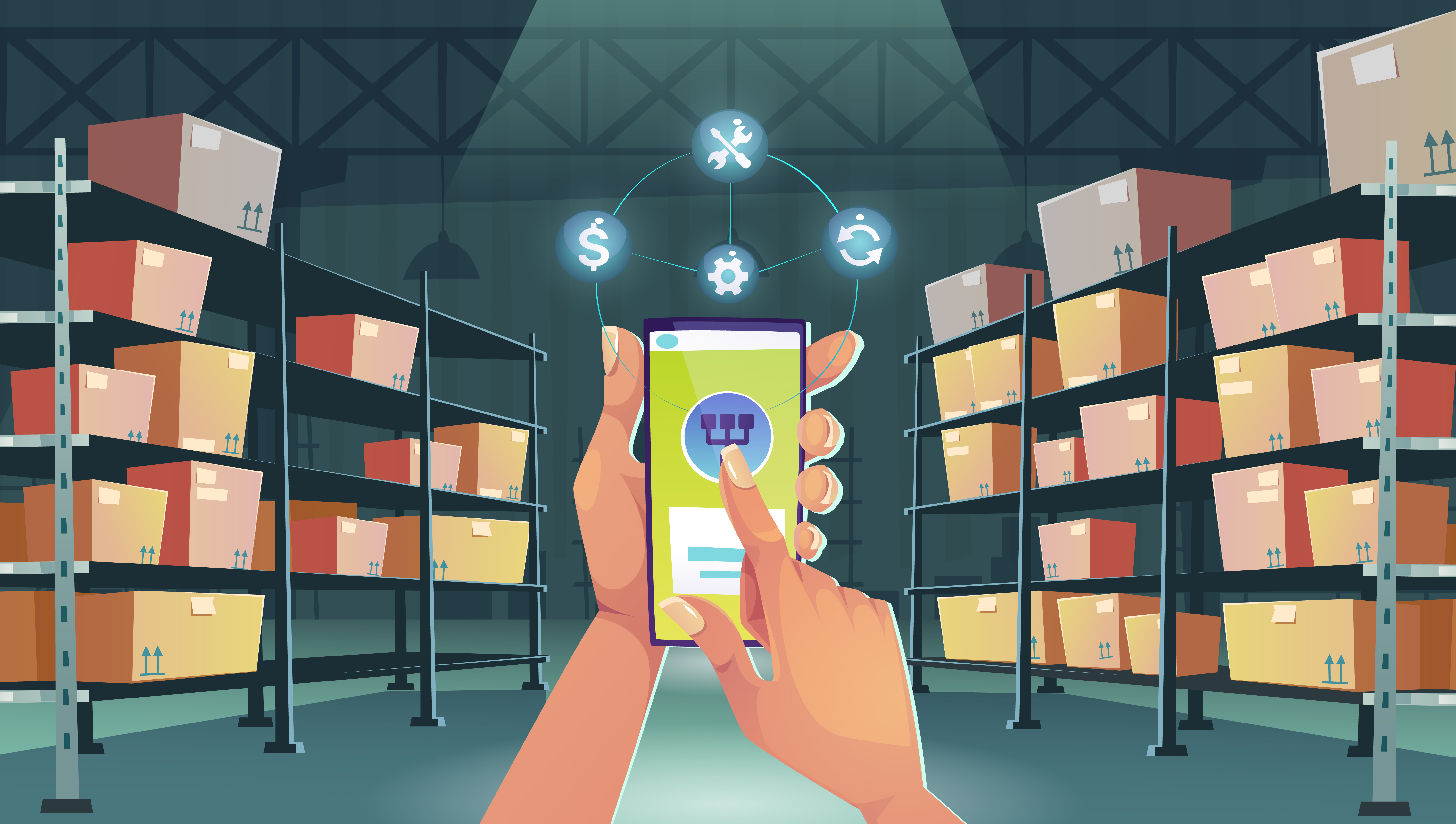Introduction
Traditional inventory management systems have certain stages of operation, going the entire distance from tracking inventory, managing inventory levels, and forecast planning to automated alerts & notifications and managing returns & damaged goods. The big players in the field are using software and hardware to ensure seamless supply chains, such as ERP applications and barcode labels and scanners, yet such solutions can be expensive in the long term and require many hands. Occupying personnel is wonderful and gives the feeling of a team, but it is undoubtedly true that the more humans are involved in repetitive tasks, the higher the chance of errors.
When we look at an object, it takes fractions of a second for us to understand what it is. That is, for objects we have already seen and understood. When it is something new, our brain takes a bit more time to process it, depending on its complexity. Looking back in time, when we were kids, there was more stuff that we had never seen before. The same applies to Computer Vision (CV). Imagine them as a baby that needs to be trained to recognise what it sees, but when it does, it can really do wonders in practically any field, including inventory management systems, which leads us to today’s topic. We will have a look at how different CV algorithms can be implemented in inventory management systems and how different approaches can improve their performance depending on the task.
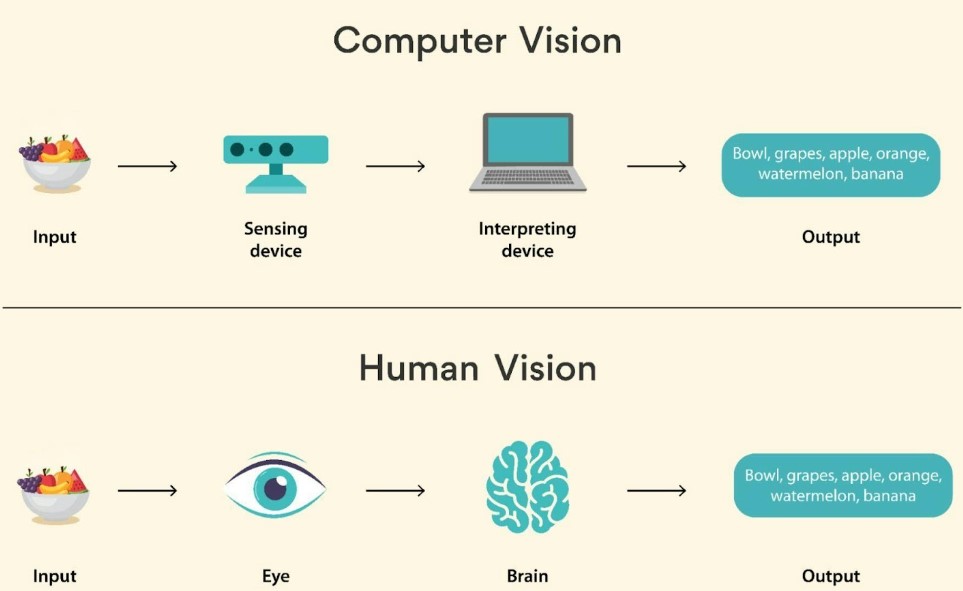
The Role of Computer Vision in Inventory Management
How Computer Vision Works
Computer Vision is the way machines interpret and analyse visual data from the real world, much like human vision. Instead of a pair of eyes, images or videos are captured through cameras, which can be conventional, thermal, or in the infrared spectrum, depending on the applications. Instead of a brain, CV algorithms process the recordings processed using an interpreting device, usually a computer or a microcontroller, to extract meaningful information. Approximately, the steps that are followed are image processing to enhance quality and reduce noise, feature extraction for shape, colour, and texture identification, and the applications of machine learning or deep learning models such as convolutional neural networks (CNNs) for pattern recognition, object classification, or anomaly detection.
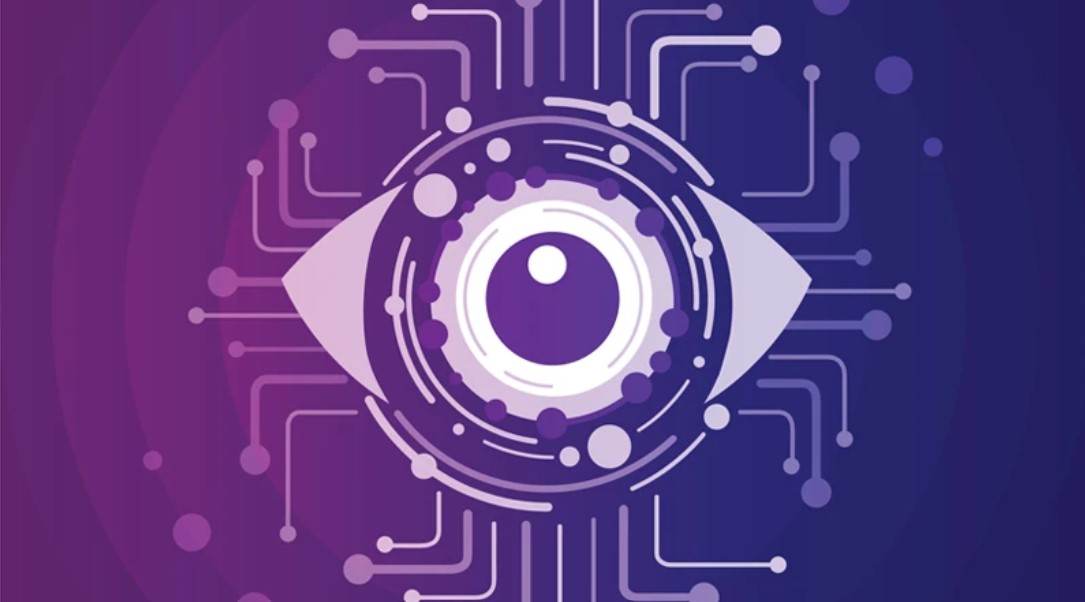
Key Benefits of Inventory Management with Computer Vision
So, how can Computer Vision work for us in inventory management? Imagine CV as an extra pair of eyes that monitor all tasks. If it is too hard, think of yourself with a super vision, without the need to rest, and with the power to make all the right decisions. We are talking about an all-in-one algorithm that can read labels, detect flaws in the production line, optimise inventory levels, perform real-time tracking of finished goods and quality control in returns, scan and categorise items for order completion and track the inventory as it moves through all stages of the supply chain during the production process. The results of such a powerful combo are guaranteed to reduce costs and time, minimise errors, and ensure maximum efficiency.
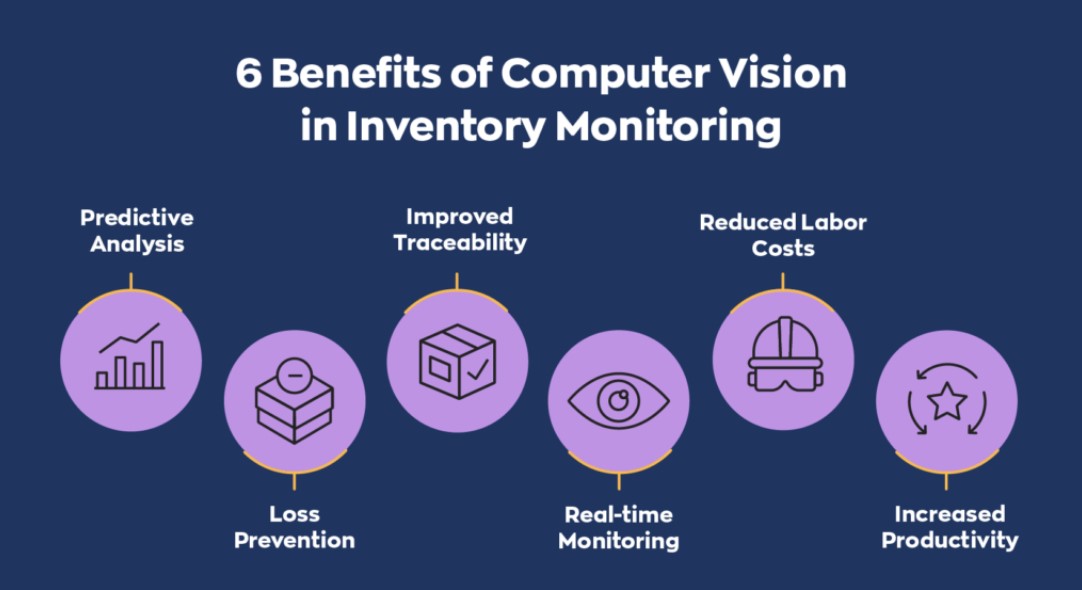
Applications and Use Cases
Manufacturing and Production Lines:
One of the trickiest things in a production line is to ensure that not only the product is good but the packaging and labels are as well. DarwinEdge is an AI solutions company for edge devices. Although they didn’t disclose exactly which, they have partnered with a leading Fast-Moving Consumer Goods (FMCG) company for real-time quality control and defect detection. Their GPU acceleration-dependent CV algorithm is built on a Python-based Keras/Tensorflow backend and trained on more than 5000 images. The prototype was deployed in a research and development lab at first to be tested on object tracking and then moved to a large-scale production line (Alfieri, 2024).

Warehousing:
Many of us have pets. If you belong to this category, you know how many items are necessary to buy. Collars, toys, trays, and most of them are expendable. However, the item that they are more prone to running out of is food. The pet food industry is a big business that needs a lot of space. Normerica Inc. is one of them, and they decided to make their life easier and grow productivity while keeping their operational expenses low by implementing IoT edge computing in their chain. In summary, they automated the pallet scanning process by implementing the Rapid Pallet Tracker (RaPTr) system from artemisVISION that uses cameras to capture and process barcode information in real time as trucks pass through a designated scanning area. Why is IoT edge computing a game changer here? Simply because it minimises latency in inventory tracking by processing data closer to the source. The end result was reduced manual scanning, minimising errors, providing immediate visibility into inventory movements, and fulfilling orders efficiently (artemisVISION, 2020).
Retail and E-commerce:
According to the world-famous CNBC, today’s concept has been embraced by one of the largest wholesale corporations in the world. Sam’s Club wants to monitor the availability of products on store shelves live, a goal achieved using CV technology. Floor scrubbers equipped with AI-capable cameras can detect low stock levels and trigger restocking processes in real time with 95% accuracy, thus ensuring that the supply chain always performs at its optimal capacity and that the inventory levels have enough quantity of goods (Caminiti, 2023).
Computer Vision and Neural Networks:
According to this study (Deng and Liu, 2021), ‘there is a better, smarter way to manage your inventory effectively by representing it using mathematics’. Reaching the proper equations gives you the opportunity to increase the parameters that you need to increase while decreasing the ones that need to be decreased. The researchers developed a Deep Inventory Management (DIM) system that leverages CNNs to predict inventory demand and detect anomalies in inventory actions. This is achieved by transforming data recorded over a given time into a supervised learning model. The model knows what the outcome needs to be based on labels, so it performs a direct comparison between them and the labels of the data fed into it. The scientists behind this claimed to have achieved an accuracy of more than 80%, leading to a reduction in inventory costs by approximately 25%!
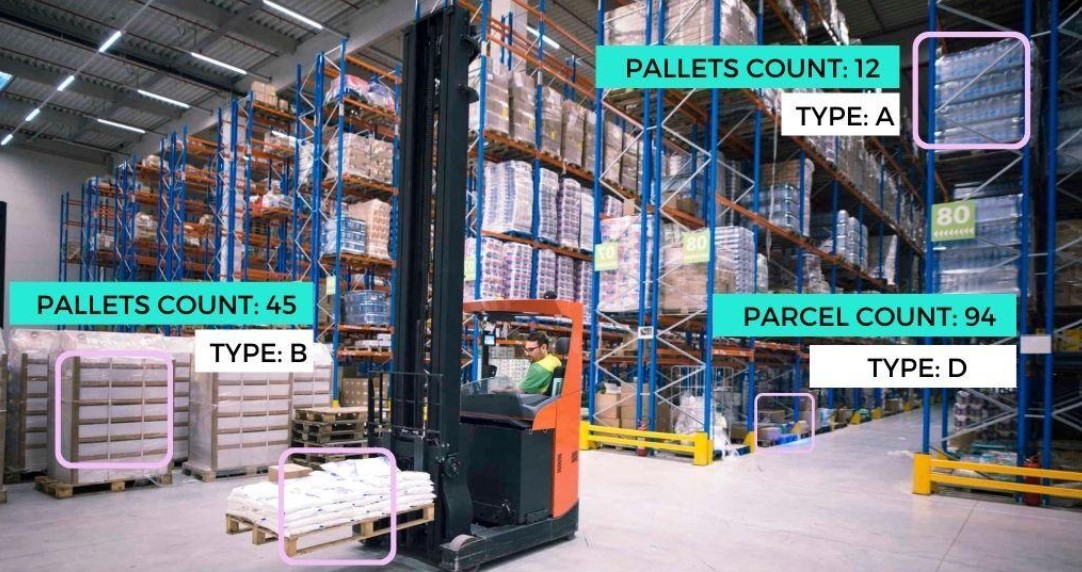
Generative AI:
The global logistics and supply chain company ‘CEVA Logistics’ came up with a very smart way to overcome potential obstacles by running multiple possible scenarios with the use of Generative AI. For that, they teamed up with Simul8, which helped them create a digital twin of their fulfilment centre. When building the digital twin, they considered both inbound and outbound phases (the phases when objects get in and out of the facility) as well as storage space. Compared to a static digital twin, their Gen AI digital twin was able to run simulations from data recorded from cameras that the algorithm could understand and evaluate. The result was an average saving of 200 working hours per week and a 2% increase in capacity across the faculty (Simul8, n. d.).
Food Industry
The food industry itself is a major field that we could talk about for hours. Actually, we have, and you can find out more about it here: How the Food Industry is Reconfigured by AI and Edge Computing!
What you won’t find there, though, is what a bakery in Japan did. Although we live in 2025 at the moment, apparently, Japan lived there in 2019. The bakery, working in a cafeteria style, used a CV system called ‘BakeryScan’ in automatic cash registers to detect the products each customer had on his tray. Although its primary goal was to update the bakery inventory in real time, the most challenging task was to distinguish croissants from bear claws, and not only did it succeed, but it did so with an accuracy of 99%. The best part isn’t there, though. The same AI system was not only great at telling apart pastries but spotting cancers as well (Neese, 2024)! If you are interested in how AI can be applied in the field of healthcare, you can read our relevant article here: How NLP Solutions Are Transforming Healthcare.
Summing Up
For many people, inventory management is a nightmare. Rightfully so, if you ask us. Yet this doesn’t mean that it can’t be simplified and easier to handle. We saw plenty of ways CV can make things easier in inventory management, with applications ranging from QC during production and packaging, smart ways to optimise inventory capacity and even automated order scanning. Although today we focused on the applications of Computer Vision in effective inventory management, you can also read our article on AI in logistics to expand your knowledge about different applications of AI in this ‘seeming simple but not quite’ field.
What We Offer
At TechnoLynx, we really get how useful Computer Vision can be, especially in inventory management applications. Our purpose is to provide custom-tailored solutions for your needs, made from scratch and specifically designed for every single project, regardless of the field. We are committed to providing cutting-edge solutions and analysing large data sets without neglecting ethical considerations or sacrificing safety in human-machine interactions.
We are committed to offering solutions that include precise software development, empowering every field and industry using innovative algorithms. We like to evolve and adapt, following the pace of the technological landscape. If your goal is to improve the accuracy, productivity, and efficiency of your project while reducing costs, you came to the right place. All you need to do is visit our Contact Us page and tell us what you need. Then, just lay back and watch your project fly through the roof!
Read more: The Impact of Computer Vision on Real-Time Face Detection
List of References
-
Alfieri, A. (2024) – Quality Control with Computer Vision and Edge AI (Accessed: 19 February 2025).
-
artemisVISION (2020) – Drive-Thru Scanning Case Study - How Normerica Grew Productivity (Accessed: 19 February 2025).
-
Caminiti, S. (2023) – How Walmart is Using A.I. to Make Shopping Better for its Millions of Customers (Accessed: 19 February 2025).
-
Deng, C. and Liu, Y. (2021) – A Deep Learning-Based Inventory Management and Demand Prediction Optimization Method for Anomaly Detection. Available at: https://doi.org/10.1155/2021/9969357.
-
Freepik (n.d.) - Hands with smartphone on warehouse interior background. Smart logistics, cargo and goods delivery postal service. Storehouse distribution business app, logistic technology, Cartoon vector illustration. Upklyak
-
inFlow Inventory (2024) – Why Supply Chains Use AI Computer Vision in Inventory Monitoring (Accessed: 25 February 2025).
-
Neese, T (2024) – From Croissants to Cancer: The Unlikely Story of an Innovative AI Solution (Accessed: 25 February 2025).
-
Ripik (2025) – Computer Vision Applications in Industry for Process Optimization (Accessed: 25 February 2025).
-
Simul8 (n.d.) – CEVA Logistics Use a Simulation-Powered Digital Twin (Accessed: 24 February 2025).
-
TELUSDigital (2021) – Computer Vision Through the Ages (Accessed: 25 February 2025).
-
Turing (n.d.) – All You Need to Know about Computer Vision and How It Works (Accessed: 25 February 2025).

